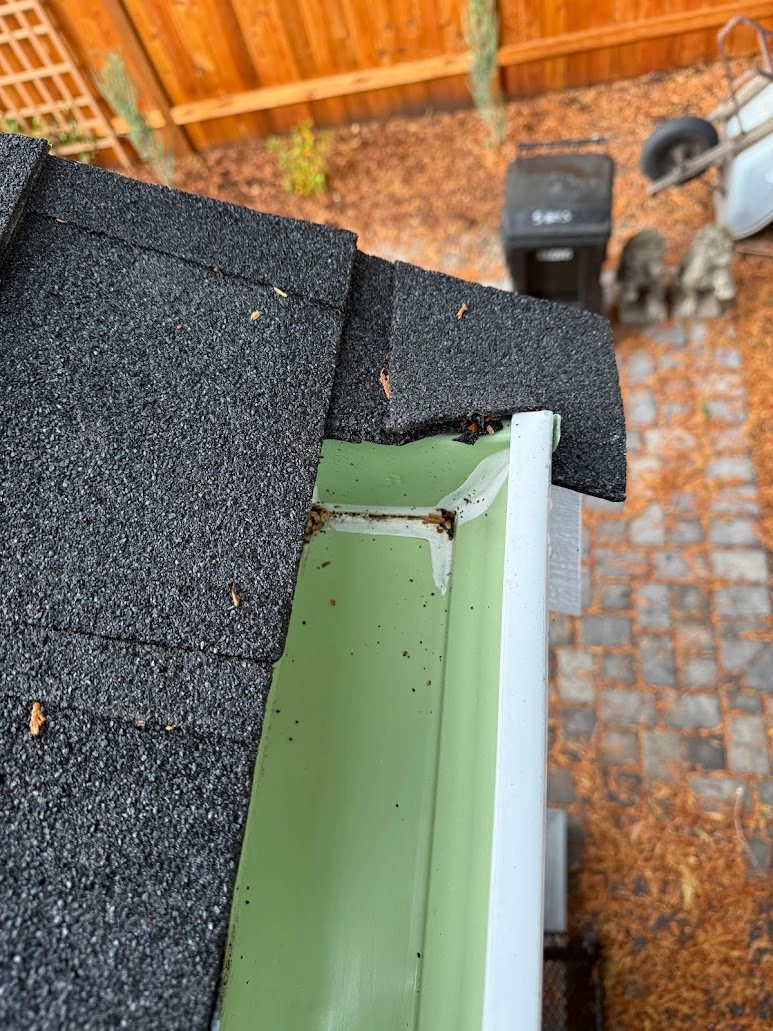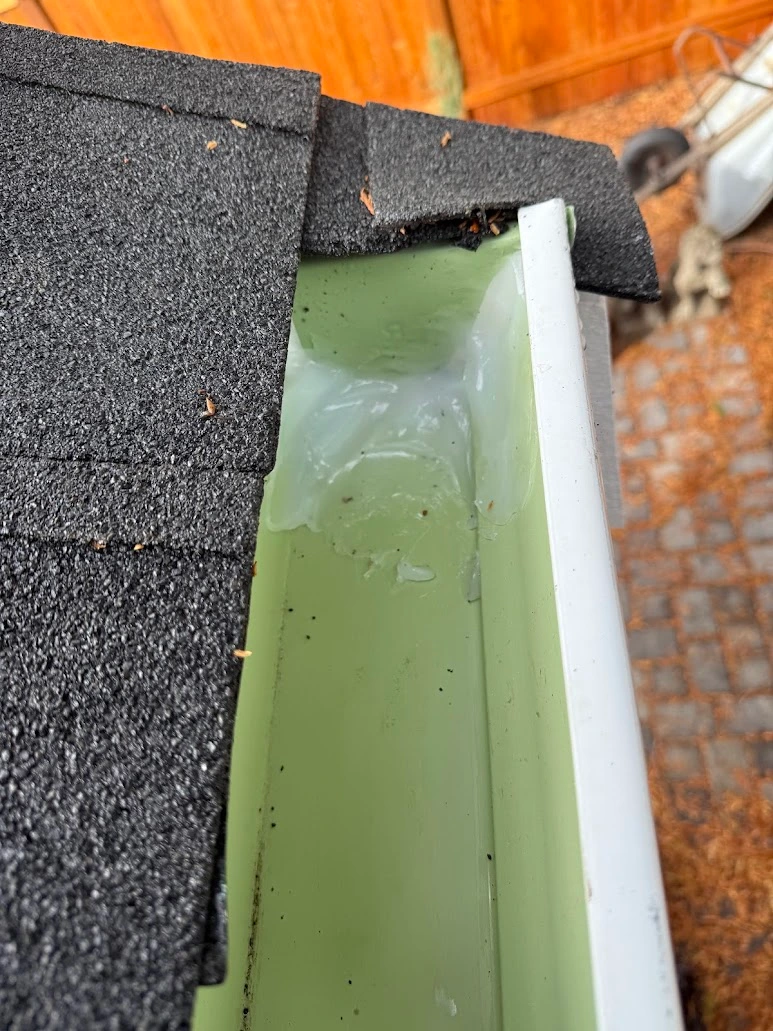
Redmond’s rolling neighborhoods hide a persistent drainage challenge: dense clay that stores every drop of rain. When gutters overflow, runoff pools beside foundations instead of seeping away like it would in Bellevue’s glacial till. Within hours, that trapped moisture seeps into crawlspaces, rots insulation, and fuels mold that spreads through floor vents. The culprit is almost always the same—a roof drainage system that can’t move water away fast enough.
1. The root cause: gutter overflow in heavy rain
Every inch of rainfall on a 2,000-square-foot roof produces roughly 1,200 gallons of water. During a typical October storm with two inches of rain, Redmond roofs shed more than 2,400 gallons in a day. Gutters and downspouts are the only engineered path that routes that volume safely off-site. When they clog or sag, water cascades over the edges, slips behind fascia boards, and lands right at the foundation.
- Compacted fir needles, maple seeds, and moss that choke troughs.
- Downspouts tied into crushed or disconnected underground drain lines.
- Misaligned hangers that create low spots and standing water.
- Debris-capped gutter guards that act like dams instead of filters.
- Missing downspout extensions that leave water dumping within five feet of the foundation.
Book professional gutter cleaning every fall before storms peak. Osprey Exterior crews vacuum, flush, and photo-document each downspout so Redmond systems move water during high-volume events instead of overwhelming the soil.
2. What clay soil does when saturated

Clay particles are tightly packed and resist infiltration. Once they get wet, they swell, lock together, and hold moisture for days. That trapped water increases hydrostatic pressure—the lateral force pushing against crawlspace footings and concrete walls. In neighborhoods like Education Hill, Grass Lawn, and Willows Creek, deep clay layers make drainage nearly impossible without mechanical help.
When roof runoff concentrates around the perimeter, pressure builds outward, cracking concrete and driving moisture inward through vents, mortar joints, and slab seams. Watch for:
- Pooling along the downhill side of your property hours after rain stops.
- Soft soil or foot imprints under crawlspace vents.
- White efflorescence lines on foundation walls.
- Persistent musty odors drifting up from the crawlspace.
Even if you never see standing water, vapor can linger in the crawlspace for weeks, raising humidity, damaging joists, and drawing pests. A targeted drainage inspection identifies whether grading, drain tiles, or sump pumps are needed to relieve that pressure.
3. Crawlspace flooding: the silent structural threat

Crawlspaces rarely get inspected until odors or soft floors appear. By then, overflow has usually followed a predictable chain reaction:
- Gutters overflow and soak soil against the foundation.
- Clay saturation prevents downward drainage, forcing water sideways.
- Hydrostatic pressure pushes moisture through vents and footing cracks.
- Relative humidity climbs above 70%, inviting mold, decay, and pests.
Remediation gets expensive fast. Dry-out services cost $1,500–$4,000, drainage retrofits add thousands more, and structural repairs escalate when rot sets in. Routine maintenance is a fraction of those reactive costs.
 Before
Before
 After
After
4. The 5-minute homeowner inspection checklist
Before you call a contractor, run a quick inspection during or immediately after light rain:
- Step 1: Walk the eaves and look for active overflow or dark water streaks.
- Step 2: Confirm each downspout discharges freely and isn’t backing up at the elbow.
- Step 3: Trace surface flow. Water should move away from the foundation, not under decks or into planting beds.
- Step 4: Inspect crawlspace vents for mud patterns or rusting screens.
- Step 5: Smell the air near the hatch; musty odors signal trapped moisture and high humidity.
Snap photos or video of anything concerning. Visual documentation helps a drainage crew prioritize which gutters, drains, or grading corrections to tackle first.
5. Permanent fixes: engineering water away

Once overflow or crawlspace flooding occurs, cleaning gutters alone may not be enough. Long-term protection addresses both the collection side (gutters, downspouts) and the dispersal side (grading, drains, pumps). For Redmond clay soils, consider:
- Downspout extensions: Solid PVC extensions carry water at least 10 feet from the foundation.
- Regrading: Establish a five percent slope away from the house for the first ten feet.
- French drains: Perforated pipe wrapped in drain rock intercepts groundwater before it hits the crawlspace.
- Sump systems: Pumps remove standing water in low crawlspaces automatically.
- Surface dispersion trenches: Gravel-lined channels absorb and slow runoff where discharge options are limited.
A clay soil drainage Redmond assessment maps soil density, elevation, and existing conveyance lines so upgrades work with your property instead of against it.
6. Documenting maintenance for insurance and resale
Carriers increasingly request proof of drainage upkeep before honoring water-damage claims. Keep digital receipts, photos, and inspection reports in one folder. Osprey Exterior’s service logs include before-and-after photos, footage counts, and downspout flow tests that insurers and HOAs accept.
These records also help during resale. Home inspectors flag stained foundations, soggy insulation, or standing water as major risk items. Showing a maintenance history reassures buyers that you’ve mitigated Redmond’s clay soil challenges.
7. Cost comparison: prevention vs. remediation

| Service type | Cost range | Frequency | Notes |
|---|---|---|---|
| Gutter cleaning | $185–$385 | Twice yearly | Removes debris and documents system condition. |
| Drain extension | $200–$600 | One-time | Directs water beyond clay-heavy planting beds. |
| Crawlspace dry-out | $1,500–$4,000 | As needed | Required after flooding to prevent mold and rot. |
| Foundation crack repair | $3,000–$8,000 | As needed | Addresses hydrostatic damage once clay soils push water inside. |
Preventive cleaning and inspection combined cost less than 10% of typical remediation work in Redmond. Budgeting for semiannual maintenance keeps gutters ready before the next Pineapple Express arrives.
8. Call in professionals when you see these signs
Schedule same-day service if you notice any of the following during a storm:
- Gutters overflowing during moderate rain.
- Soft, sponge-like soil along the foundation perimeter.
- Muddy crawlspace vents or water staining on foundation walls.
- Sections of gutter pulling away from fascia boards.
- Visible water lines or damp insulation under flooring.
Our Redmond-based crews are licensed, bonded, and rope-access certified for multi-story homes. Every visit includes photo documentation and a follow-up checklist so you know the system will perform. Review our emergency gutter cleaning guide to prepare for the next storm.
9. Building a Redmond-specific maintenance routine
Use this calendar to keep gutters, drains, and documentation ready year-round:
| Month | Task | Purpose |
|---|---|---|
| March | Pre-season gutter clean | Clear pollen, fir cones, and moss before spring showers. |
| May | Flow test downspouts | Verify underground pipes and rain leaders are unobstructed. |
| September | Full cleaning & flush | Prepare for fall storms and document condition for insurance. |
| December | Mid-winter touch-up | Remove fir needles, confirm extensions, and check for ice buildup. |
Automate these appointments through our Redmond scheduling hub so slots are reserved before the rainy season peaks.
10. Protect your foundation before it’s too late

Redmond’s clay-heavy soils leave no margin for gutter neglect. Once crawlspaces flood, water lingers for weeks and drives costly structural repairs. Don’t wait for the next atmospheric river to expose weak spots. Schedule a full gutter and drainage inspection with Osprey Exterior to receive flow verification, geotagged photos, and a maintenance report you can keep on file.
